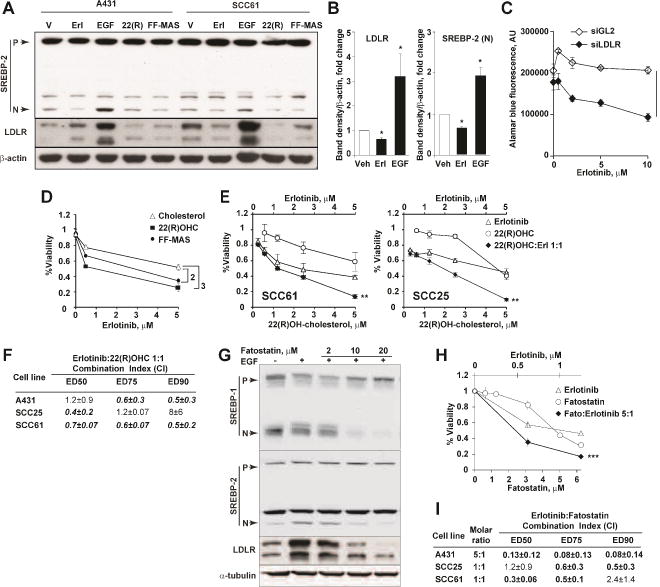Figure 5.

EGFR and LXR signaling co-regulate cholesterol pathway targets in carcinoma. (A) Activation (EGF) or blockade of EGFR (erlotinib) regulates cholesterol metabolism via the expression of nuclear SREBP2 and LDLR in EGFR-positive A431 and SCC61 cells. Conversely, LXR agonists FF-MAS and 22(R)-hydroxycholesterol reduce the expression of nuclear SREBP2 and LDLR. (B) Summary of results quantified from (A) for SCC61 cells; *, p=0.02. (C) Silencing of LDLR with siRNA sensitizes refractory SCC61 cells to erlotinib. Bars, SEM from 3 independent experiments; (1) p=3*10−11. See also Figure S6. (D) Addition of 3 μM FF-MAS or 3 M 22(R)-hydroxycholesterol increased cytotoxicity of erlotinib in SCC25 cells. Data are represented as mean±SEM of 3 repeats; interaction, p=0.003 (2) and p=0.0002 (3), two-way ANOVA test. (E) Combined effects of erlotinib and 22(R)-hydroxycholesterol SCC61 and SCC25 cells; interaction, **, p<0.01. (F) Enumeration of erlotinib and 22(R)-hydroxycholesterol interactions in vitro. Shown are averaged Chou-Talalay CI values ±SEM from at 3 independent repeats. ED, effective dose; CI, combination index. See also Figure S6. (G) Effects of fatostatin on SREBP1, SREBP2 and LDLR expression in A431 cells following treatment of serum-starved cells with EGF (20ng/ml) and/or fatostatin for 18 hours. (H) Combined effects of erlotinib and fatostatin in A431 cells; interaction ***, p<10−3. (I) Enumeration of erlotinib and fatostatin interactions in vitro as in (E).
